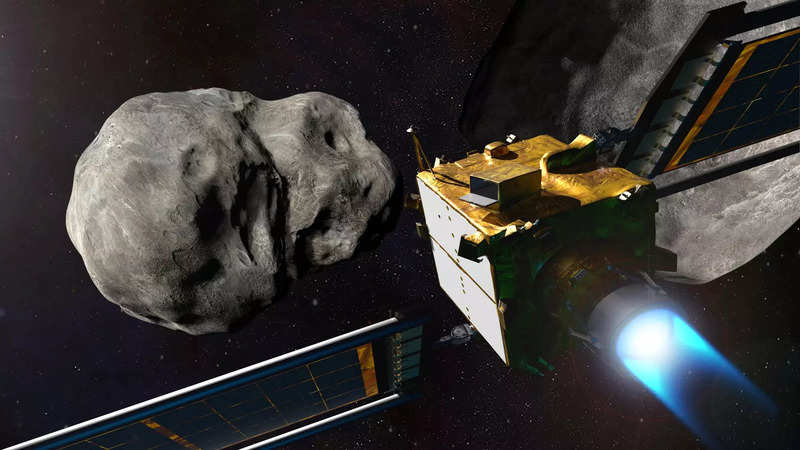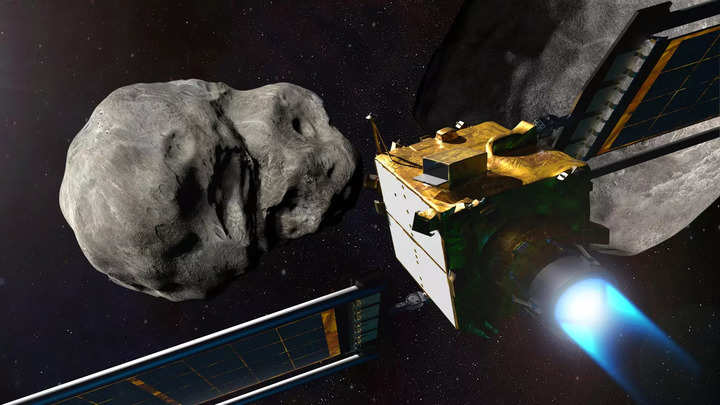

After flying in area for 10 months, a NASA spacecraft efficiently crashed into an asteroid in a first-of-its-kind mission to check whether or not area rocks that may threaten Earth sooner or later might be nudged safely out of the way in which, the US area company stated.
The Double Asteroid Redirection Test (DART) – the world’s first planetary defence know-how demonstration — focused the asteroid moonlet Dimorphos, a small physique simply 160 metres in diameter.
Dimorphos orbits a bigger 780-metre asteroid known as Didymos. Neither asteroid poses a risk to Earth.
Learn Additionally

The mission’s one-way journey confirmed NASA can efficiently navigate a spacecraft to deliberately collide with an asteroid to deflect it, a way often known as kinetic affect, the company stated.
“At its core, DART represents an unprecedented success for planetary protection, however additionally it is a mission of unity with an actual profit for all humanity,” stated NASA Administrator Bill Nelson.
“As NASA research the cosmos and our residence planet, we’re additionally working to guard that residence, and this worldwide collaboration turned science fiction into science reality, demonstrating one strategy to shield Earth,” Nelson stated in an announcement.
The group will now observe Dimorphos utilizing ground-based telescopes to verify that DART’s affect altered the asteroid’s orbit round Didymos.
Researchers anticipate the affect to shorten Dimorphos’ orbit by about 1 per cent, or roughly 10 minutes. Exactly measuring how a lot the asteroid was deflected is among the major functions of the full-scale check.
“Planetary Defence is a globally unifying effort that impacts everybody dwelling on Earth,” stated Thomas Zurbuchen, affiliate administrator for the Science Mission Directorate at NASA.
“Now we all know we will goal a spacecraft with the precision wanted to affect even a small physique in area. Only a small change in its pace is all we have to make a major distinction within the path an asteroid travels,” Zurbuchen stated.
The spacecraft’s sole instrument, the Didymos Reconnaissance and Asteroid Digital camera for Optical navigation (DRACO), along with a complicated steerage, navigation and management system enabled DART to determine and distinguish between the 2 asteroids, focusing on the smaller physique.
These techniques guided the 570-kilogramme box-shaped spacecraft via the ultimate 90,000 kilometers of area into Dimorphos, deliberately crashing into it at roughly 22,530 kilometers per hour to barely sluggish the asteroid’s orbital pace.
DRACO’s ultimate photographs, obtained by the spacecraft seconds earlier than affect, revealed the floor of Dimorphos in close-up element.
Fifteen days earlier than affect, DART’s CubeSat companion Gentle Italian CubeSat for Imaging of Asteroids (LICIACube), supplied by the Italian Area Company, deployed from the spacecraft to seize photographs of DART’s affect and of the asteroid’s ensuing cloud of ejected matter.
In tandem with the pictures returned by DRACO, LICIACube’s photographs are meant to offer a view of the collision’s results to assist researchers higher characterise the effectiveness of kinetic affect in deflecting an asteroid.
“DART’s success gives a major addition to the important toolbox we should have to guard Earth from a devastating affect by an asteroid,” stated Lindley Johnson, NASA’s Planetary Protection Officer.
“This demonstrates we’re not powerless to forestall any such pure catastrophe.
“Coupled with enhanced capabilities to speed up discovering the remaining hazardous asteroid inhabitants by our subsequent Planetary Protection mission, the Close to-Earth Object (NEO) Surveyor, a DART successor may present what we have to save the day,” Johnson stated.
With the asteroid pair inside 11 million kilometers of Earth, a world group is utilizing dozens of telescopes stationed all over the world and in area to look at the asteroid system.
Over the approaching weeks, they’ll characterise the ejecta produced and exactly measure Dimorphos’ orbital change to find out how successfully DART deflected the asteroid.
The outcomes will assist validate and enhance scientific pc fashions essential to predicting the effectiveness of this system as a dependable technique for asteroid deflection.
Learn Additionally

“This primary-of-its-kind mission required unbelievable preparation and precision, and the group exceeded expectations on all counts,” stated Ralph Semmel, Director on the Johns Hopkins Utilized Physics Laboratory (APL) which managed the mission.
“Past the really thrilling success of the know-how demonstration, capabilities based mostly on DART may in the future be used to vary the course of an asteroid to guard our planet and protect life on Earth as we all know it,” Semmel added.
FbTwitterLinkedin






